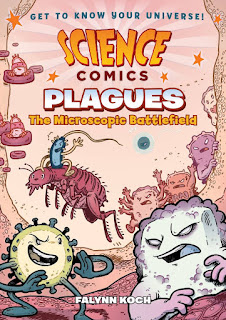I have to say that I've only ever read one graphic novel narrated by a scientist, a white blood cell, a Bubonic Plague bacterium, and a yellow fever virus. Plagues: The Microscopic Battlefield does not skimp on innovations just with its narrators; it also presents innovative ways of combating disease in a very subtle way. This book ostensibly tackles many issues, proving insight into how human beings developed germ theory over time, highlighting some key figures such as Edward Jenner and Louis Pasteur along the way. It also defines the various types of micro-organisms and how they operate in the natural world. It explains various instances of outbreaks, plagues, and notable breakthroughs in medical treatment, culminating in the ways that the scientist in this book proposes to repurpose once deadly germs, like the aforementioned Plague bacterium and yellow fever virus, into fighting for protecting human hosts from disease. I really enjoyed reading about this progression in the state of the art over a period of centuries. This graphic novel is excellent both as a science text and as a human history.
This book covers many a gross topic (pus, lesions, Gangrene) as well as few potentially difficult ones (STDs, immunization), and does so in honest, straight-forward fashion. I also very much liked its playful tone, characterized by the back-and-forth dialogue between the narrators. They all have very defined personalities, some more ornery than others, and very distinct viewpoints about their roles in the world. I felt that this personable approach to this material made a whole lot of technical jargon and technical explanation much more palatable and digestible. And at the same time, once I caught on to the setting in a technological simulation (I was a mite confused by it early on, as it's not explicitly defined), I got very swept up in the goings on of this book. It is a brisk, fun, and highly informative read, indicative of the high quality of the entire Science Comics series.
This book's creator Falynn Koch is a graduate of SCAD and her graphic novel debut was on the Bats book in this same series. I feel her work on Plagues might even be stronger than on her first book, and I admired how well she balanced a sense of play with a sense of wonder as well as including so much pertinent information in efficient manner. She speaks about her work on both Science Comics books in this interview.
All of the reviews I have read about this book have been positive. Kirkus Reviews wrote that Koch "injects heady doses
of both history and histology into the tour, lightens the load with humor (of a
sort: “Ha! Jenner put a lot of pus in that kid!”), and hints at promising new
directions in medical research." Johanna Draper Carlson stated, "I suspect younger readers will enjoy the battles between the monster-influenced, anthropomorphized cells and germs." Martha Dodge called it "A solid choice for fans of biology (but good for non-scientists too!)."
Science Comics: Plagues was published by First Second, and they offer a preview and much more here.



Thanks, helped me a lot on my homework.
ReplyDelete